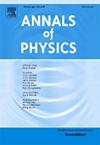Antiferromagnetic diamond network as an efficient spin filter: Proposition of a spin-specific semi-conducting behavior
IF 3
3区 物理与天体物理
Q2 PHYSICS, MULTIDISCIPLINARY
引用次数: 0
Abstract
We propose, for the first time, that an array of diamond plaquettes, each possessing vanishing net magnetization, can achieve complete spin polarization over a broad bias window. Furthermore, this system can be utilized to realize spin-specific semiconducting behavior. We describe the antiferromagnetic diamond network within a tight-binding framework, where spin-dependent scattering arises due to the interaction between itinerant electrons and local magnetic moments at different lattice sites. The mechanism underlying spin filtration relies on the specific arrangement of magnetic moments within individual plaquettes. We systematically investigate the spin polarization phenomenon under various input conditions, examining its dependence on network size, system temperature, and the magnetic flux threading each plaquette. Due to the network’s geometry, we identify a sharply localized, highly degenerate energy level coexisting with conducting states. By tuning physical parameters, a small energy gap can be established between these degenerate localized states and the conducting energy band, enabling spin-specific -type and -type semiconducting behavior. Our findings offer a novel approach for designing future spintronic devices based on similar antiferromagnetic networks.
反铁磁金刚石网络作为一种有效的自旋滤波器:自旋特定半导体行为的命题
我们首次提出,一组金刚石斑块,每个具有消失的净磁化,可以在宽偏置窗口内实现完全自旋极化。此外,该系统可用于实现自旋特定的半导体行为。我们在一个紧密结合的框架内描述了反铁磁金刚石网络,其中自旋相关散射是由于巡回电子和不同晶格位置的局部磁矩之间的相互作用而产生的。自旋过滤的机制依赖于单个血小板内磁矩的特定排列。我们系统地研究了不同输入条件下的自旋极化现象,考察了其对网络大小、系统温度和穿过每个磁片的磁通量的依赖。由于网络的几何形状,我们确定了一个与导电状态共存的尖锐局域化,高度简并的能级。通过调整物理参数,可以在这些简并局域态和导电能带之间建立一个小的能隙,从而实现自旋特异性的p型和n型半导体行为。我们的发现为设计基于类似反铁磁网络的未来自旋电子器件提供了一种新方法。
本文章由计算机程序翻译,如有差异,请以英文原文为准。
求助全文
约1分钟内获得全文
求助全文
来源期刊

Annals of Physics
物理-物理:综合
CiteScore
5.30
自引率
3.30%
发文量
211
审稿时长
47 days
期刊介绍:
Annals of Physics presents original work in all areas of basic theoretic physics research. Ideas are developed and fully explored, and thorough treatment is given to first principles and ultimate applications. Annals of Physics emphasizes clarity and intelligibility in the articles it publishes, thus making them as accessible as possible. Readers familiar with recent developments in the field are provided with sufficient detail and background to follow the arguments and understand their significance.
The Editors of the journal cover all fields of theoretical physics. Articles published in the journal are typically longer than 20 pages.
 求助内容:
求助内容: 应助结果提醒方式:
应助结果提醒方式:


